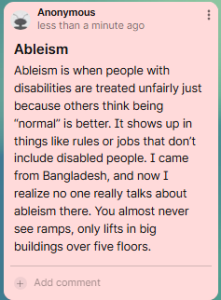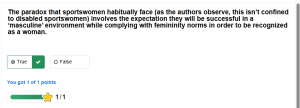5
Section one: The fundamentals
A)
Exercise 1: Notebook Prompt
Many of you are likely familiar with the concept of “ability inequity,” which the authors of this article define as “an unjust or unfair (a) ‘distribution of access to and protection from abilities generated through human interventions’ or (b) ‘judgment of abilities intrinsic to biological structures such as the human body’.”
However, they go on to identify the following “ability concepts” that are less familiar:
1) ability security (one is able to live a decent life with whatever set of abilities one has)
2) ability identity security (to be able to be at ease with ones abilities)
How prevalent are these forms of security among disabled people you know? Or, if you identify as a disabled person, would you say your social surroundings and community foster and support these kinds of security? Furthermore, while the focus of the article is on Kinesiology programs, it is also important to reflect on how academia in general accommodates for disability. If you feel comfortable answering this question, what has been your experience of postsecondary education to date?
-OR-
The authors also observe that “Ableism not only intersects with other forms of oppression, such as racism, sexism, ageism, and classism, but abilities are often used to justify such negative ‘isms’.”
What do you think this means? Provide an example.
| “Ableism not only intersects with other forms of oppression, such as racism, sexism, ageism, and classism, but abilities are often used to justify such negative ‘isms’.”
It means that people often face unfair treatment because others think they are incapable of doing something, this is called ableism. But this unfair treatment is not the only thing that happens. It blends with other issues such as ageism, sexism, and racism. For example, someone may say that a woman lacks the strength to participate in a sport. That is ableism as well as sexism, or someone might say that a member of a particular race is not intelligent enough for school, this is ableism and racism. According to the authors, people frequently use their abilities as a justification for treating others poorly, which worsens other forms of unfair treatment. As I had mentioned before, I played Football U-18 and also watch it regularly, but one of the things that bugged me about FA was that they had women banned from playing it saying it was unsuitable for women. The ban lasted 50 years from 1921 and later they even tried to justify the ban. This is ableism and sexism. Reference: https://www.theguardian.com/football/2022/jun/13/how-the-fa-banned-womens-football-in-1921-and-tried-to-justify-it
|
Exercise 2: Implicit Bias Test
Did anything surprise you about the results of the test? Please share if you’re comfortable OR comment on the usefulness of these kinds of tests more generally.
| It did not suprise me, when sorted by age, it showed Older people associated White with Good faster which only shows the belief I already had of older people being more racist honestly. I have faced it myself. Good to see younger generation have a better open thinking towards all these.
What does shock me that it was only 3% who were faster at sorting Black with Good, but I am guessing this is because of the way the question was given to us. Black being on left side of the keyboard first, also negative words being on the left, then probably the switch made everyone slow down later on.
|
B) Keywords
Exercise 3:
Add the keyword you contributed to padlet and briefly (50 words max) explain its importance to you.

Ableism is when people with disabilities are treated unfairly just because others think being “normal” is better. It shows up in things like rules or jobs that don’t include disabled people. I came from Bangladesh, and now I realize no one really talks about ableism there. You almost never see ramps, only lifts in big buildings over five floors.
|
B) On Disability
Exercise 4: Complete the Activities



Exercise 5: Notebook Prompt
What do Fitzgerald and Long identify as barriers to inclusion and how might these apply to sport in particular?
According to Fitzgerald and Long, there are many barriers that prevent disabled people from participating in sports. First, there are those who believe that disabled persons should only participate in sports to improve their health. They feel excluded as a result. Real issues also exist, such as structures lacking ramps, specialized tools, or skilled assistants. I saw this myself in Bangladesh, where very tall buildings are the only ones with elevators and most areas even lack ramps. Playing with non-disabled people might make handicapped persons anxious or ashamed because they fear being judged or not being able to keep up. Non-disabled individuals occasionally ignore them or make no effort to support them in joining. Because they are unable to comprehend what is said or do not receive help, those with hearing or learning disabilities may find it considerably more difficult. These factors all contribute to the belief that sports are exclusive.
C) Inclusion, Integration, Separation
Exercise 6: Complete the Activities

Exercise 7: Notebook Prompt
Choose ONE of the three questions Fitzgerald and Long argue disability sport needs to address and record your thoughts in your Notebook.
- Should sport be grouped by ability or disability?
- Is sport for participation or competition?
- Should sport competitions be integrated?
| 2. Sport is for competition and also for participation. Participating in sports can help people meet new people, keep healthy, have fun, and love being a part of a team or group. It makes people feel pleased, engaged, and included. Others take part in sports in order to compete, succeed, and improve their abilities. They enjoy the thrill and challenge of competing with other players. This is a competition, both are valuable and significant. It is acceptable that not everyone strives to be the best. Everyone should be able to participate in sports, regardless of whether they are doing it for enjoyment, fitness, or competition.
|
Part Two: Making Connections
A) Gender, Sport and Disability
Exercise 8: Complete the Activity
The paradox that sportswomen habitually face (as the authors observe, this isn’t confined to disabled sportswomen) involves the expectation they will be successful in a ‘masculine’ environment while complying with femininity norms in order to be recognized as a woman.
True or false?
Take a moment to reflect on this paradox below (optional).
 |
B) Masculinity, Disability, and Murderball
Exercise 9: Notebook/Padlet Prompt
Watch the film, Murderball and respond to the question in the padlet below (you will have an opportunity to return to the film at the end of this module).
The authors of “Cripping Sport and Physical Activity: An Intersectional Approach to Gender and Disability” observe that the “gendered performance of the wheelchair rugby players can…be interpreted as a form of resistance to marginalized masculinity” (332) but also point out that it may reinforce “ableist norms of masculinity.” After viewing the film, which argument do you agree with?
a) Murderball celebrates a kind of resistance to marginalized masculinity
| d) Murderball does both of these things.
The film shows how the athletes push back against the idea that men with disabilities are weak or not masculine. They play a tough sport, show strength, and talk openly about their lives. This challenges the stereotype that disabled men can not be strong or competitive. In this intense rivalry between the U.S. and Canadian teams, we see Team USA’s captain, Mark Zupan, is fierce and outspoken. He grew to attention in the sport as a top player, known for his strong style and leadership, following a horrific accident that left him crippled, and also rehabilitation journey of a newcomer Keith Cavill, and more.
|
Section Three: Taking a Shot
A) Resistance
B) Calling out Supercrip
Exercise 10: Mini Assignment (worth 5% in addition to the module grade)
1) Do you agree with the critique of the “supercrip” narrative in this video? Why or why not? Find an example of the “supercrip” Paralympian in the 2024 Paris Paralympics or Special Olympics coverage and explain how it works.
| Yes I do agree with the critique in this video, the video may unintentionally suggest that handicapped people must do amazing feats in order to be respected, even while its goal is to inspire by highlighting the extraordinary accomplishments of people with impairments. The significance of everyday events and the importance of societal inclusion may be ignored by this point of view.
A good example of the supercrip story is how the media talked about Moroccan Paralympic athlete Aymane El Haddaoui at the 2024 Paris Paralympics. He won a bronze medal in the 100 meters and a gold medal in the 400 meters, even breaking a world record with a time of 46.65 seconds. The news focused a lot on how he worked hard, came from Morocco, and became a big success. While his story is amazing, only talking about his big wins can be a problem. It makes it seem like people with disabilities need to do something great to be accepted, instead of just being seen as equal in everyday life. This fits into the supercrip narrative we learn, it shows that people with disablities as heroes only when they achieve something. The problem is that not all disabled people are athletes or record breakers. Many are just trying to live normal lives, go to school, have jobs, and be part of their communities. Their lives matter too, even if they do not make the headlines. John Loeppky’s views in Grappling with Ableism in the Para-Sport Movement are relevant to this type of narrative. According to him, handicapped athletes are frequently portrayed in ways that are comforting to those without disabilities, praising their power, self-reliance, and incredible achievements. But this can be problematic since it ignores a large number of handicapped persons who could not get medals but still need support and respect.
|
2) (read this blog for some ideas)?
(300 words for each response)
| Yes, there is some supercrip narrative connection in the movie Murderball. It challenges stereotypes about handicapped people being weak or dependent by presenting wheelchair rugby players as powerful, combative, and competitive. However, the movie follows to the supercrip stereotype by highlighting their capacity to overcome limitations through exceptional toughness, implying that crippled people must accomplish remarkable things in order to be valued. The importance of ordinary experiences and contributions may be overshadowed by this narrative, which may unintentionally put pressure on handicapped people to constantly show their value. The video also discusses being a true man a lot. The athletes show behaviours that are viewed as particularly masculine, such as aggression and emotional detachment. This might give children a sense of strength, but it also implies that you have to behave a specific way in order to be a man. For those who do not fit that stereotype, this can be challenging.
In his blog, Ben Mattlin addresses stories like these, he claims, might give handicapped individuals the impression that they must constantly be an inspiration.He says this can be tiring and stressful, because it means disabled people are not allowed to just be themselves. They are judged not by who they are, but by what they can achieve. Mattlin believes disabled people should be accepted for who they are, whether or not they do something that others see as amazing. He wants people to understand that everyday lives and experiences matter too, not just the big achievements. Murderball challenges certain misconceptions about handicapped people while also showing that they need to be extremely powerful in order to be recognized. But at the same time, it also reinforces some ideas that can be harmful. It leaves out many people who do not or ca not meet those expectations. True equality means accepting all kinds of people and experiences.
|
Extra Credit Option:
3) How does the film model resistance to both disability and gender norms, and in what ways do the athletes redefine or subvert societal expectations of strength, independence, and masculinity?
Answer: As I have already mentioned, Murderball shows those wheel chair athletes as someone playing a tough sport and that they are very strong, competitive and can do anything on their own. This is good and I am in for it, but it also pushes pressure on other wheel chair or even differently abled people to do something out of the ordinary to feel valued. Like I am personally no great athlete or anyone who has done something that would be praised by the world, but it still does not put any pressure on me because soceity does not look at me differently because of it, but it is not the same for them. In the film we see, Bob Lujano is open about his emotions, which contrasts with the idea that men should always be stoic. The film also explores the personal lives of the athletes, including their relationships and vulnerabilities, providing a more complete picture of their experiences. Misconceptions regarding the sexuality of those with disabilities are also addressed. The athletes challenge the widespread belief that people with disabilities are not sexually active by being open about their sexual experiences. The idea that individuals with impairments may have satisfying sexual lives is normalized by this openness. By showing great physical and emotional depth, athletes in the film challenge biases and show that power and masculinity are not limited by a disability. By emphasizing resiliency and redefining what it means to be independent and masculine, their stories defy social norms.

